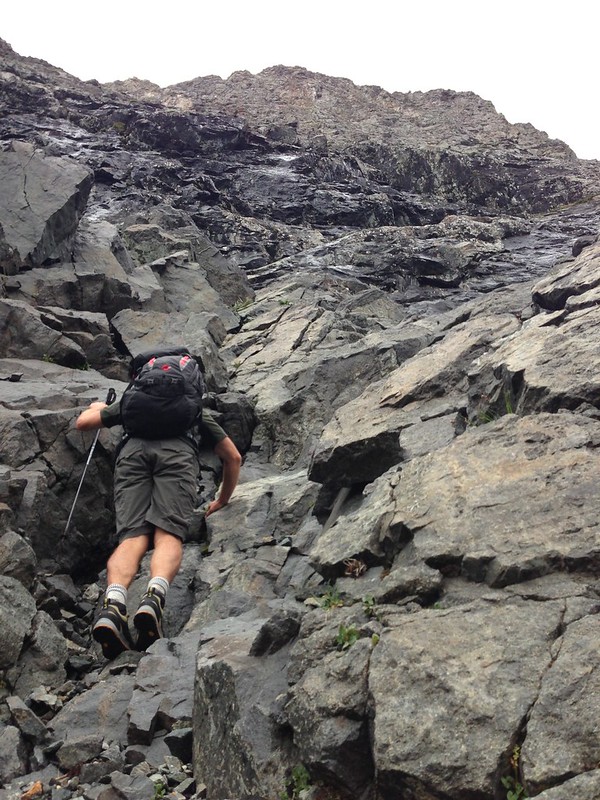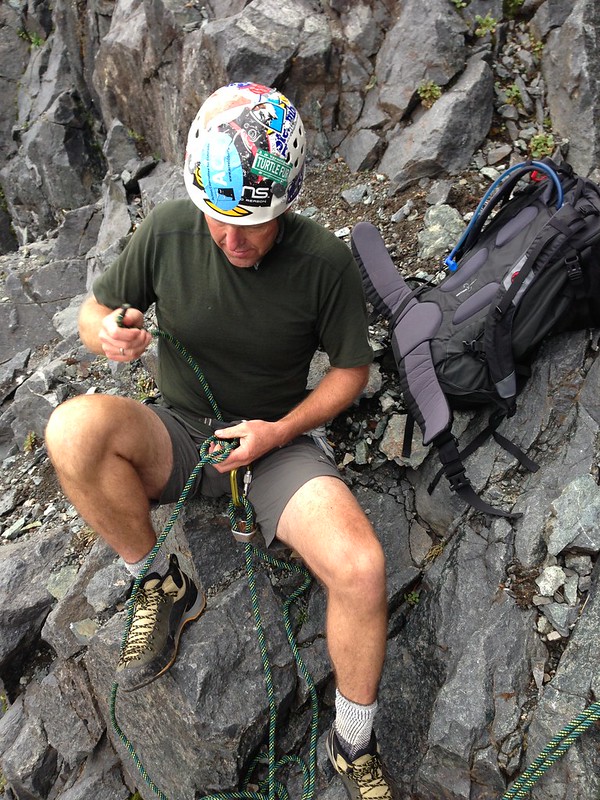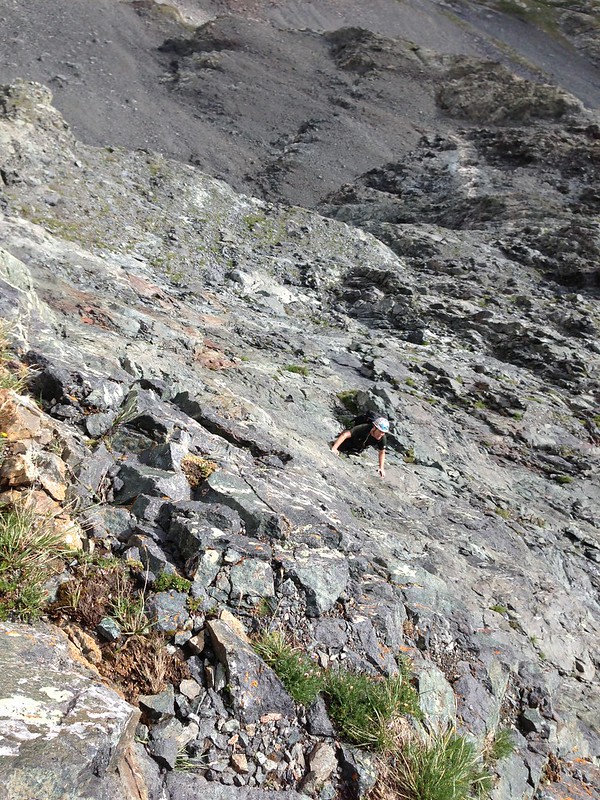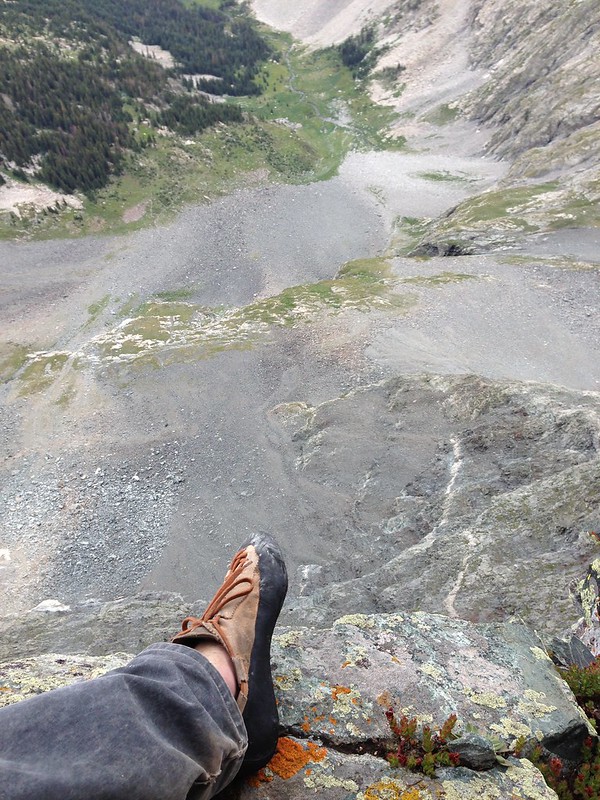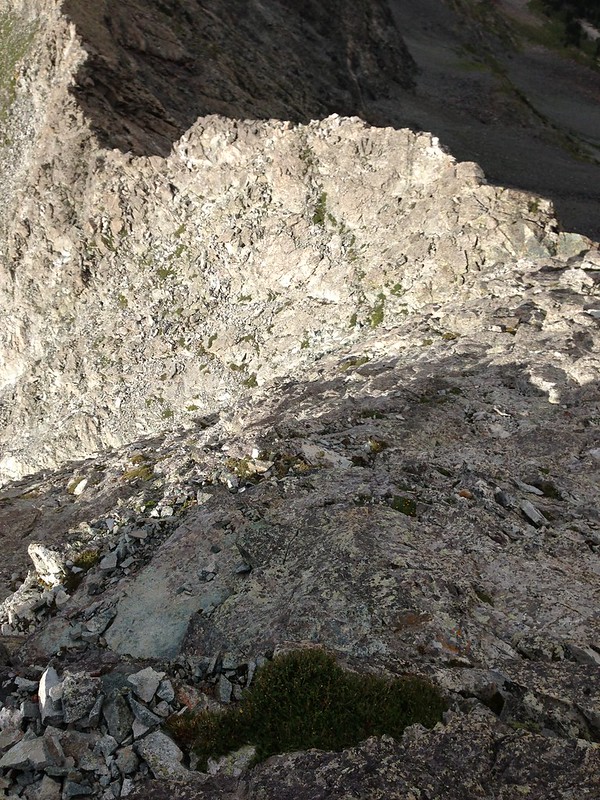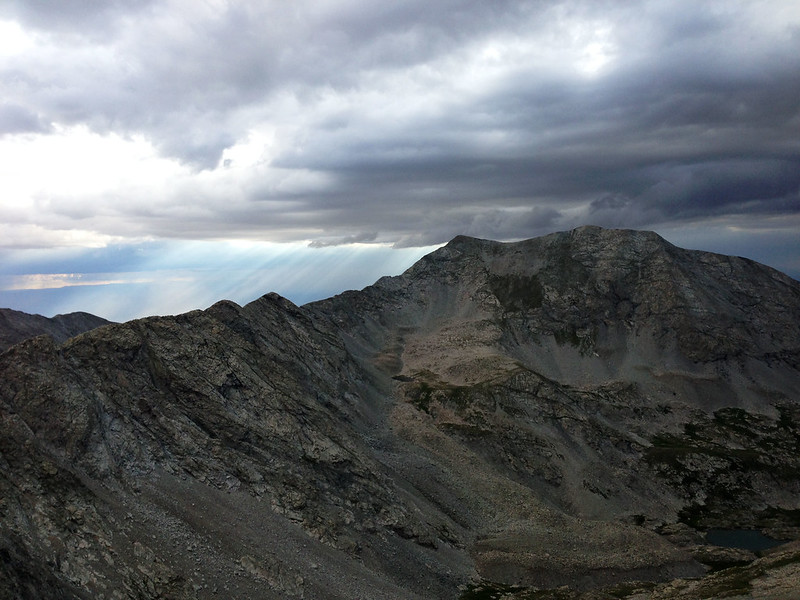Ellingwood Point - The Hard Way Up
Blanca Peak is a Colorado fourteener, meaning it is one of the fifty or so peaks in the state that reaches above 14,000 feet above sea level. Blanca sits an impressive fourth-highest in the state at 14,344 feet. I did not climb Blanca Peak. Instead, I accidentally made the first ascent up the west face of Ellingwood Point - a subpeak that neighbors Blanca just to the north. Whoops.
It started with an email from Don Morris, a name I knew only in passing. It was an email blast to a bunch of people asking if anyone was interested in climbing Blanca Peak by way of the Ormes Buttress route - a 2,000 vertical foot moderately rated alpine route. My love for alpine climbing is no secret, so I replied immediately and we set a date.
The plan was to drive up to the trailhead Friday evening and hit the trail first thing Saturday to do the climb car to car in one day. Easy enough, in and out. We met at a parking lot in Morisson to get in one car for the three hour journey. I threw my gear into his Subaru and we were off to the base of the mountain to camp for the night.
We arrived and set up tents, ate a quick dinner and shared climbing stories for a bit. Don had a 14ers guide book that listed the Ormes route, so we studied that as well. We set our alarms for 5 the following morning and went to sleep as early as we could manage, about 10:30 or so.
The alarms went off in the morning, I made a quick cup of coffee (about the only ritual in my life) and we hit the trail under the dim glow of our headlamps. The approach to the base of the climb is about seven miles in, and we covered it quickly as the sun rose.

Crossing a stream on the appraoch
We paused as we neared the base of the cliff towering over our heads to review our route up. We were over 12,500 feet up already, and the elevation must have just been starting to affect us. We compared notes, and checked the guides again. We both had printed copies of the route description as well as photographs of what features to look for at the start of the climb.
We had decided on our line and went to the base of the rock to gear up for the ascent. When we got close to the feature we wanted to start on, we noticed that the climbing was easier than we'd anticipated. We made the brilliant decision to free solo the first bit of the climb to save time.
I've soloed a bit, both roped with a silent partner and unroped, or free soloing. I've soloed the first three flatirons many times, and feel quite comfortable on moderately graded rock climbs. That said, looking two thousand feet straight up is daunting, knowing you have only your gear, your partner and your wits about you to make it to the summit.
After a bit, the rock got a tad steeper and wet. Nothing is worse than wet rock on a clear day as it ruins any advantage climbing shoes have over even bare feet. We decided it would be to our benefit to don our harnesses and rope up.
And boy am I glad we did. I was up first to lead, so I took the sharp end of the rope and started up a wet ramp, dripping water from deep inside the rock. We didn't carry a ton of gear to save some weight, so I managed to make a solid gear placement every 20-30 feet or so - enough to arrest a fatal fall to the ground, but not exactly reassuring to my my just-waking-up brain.
We were also using a 50 meter rope, a common length for alpine climbs. It's shorter than most ropes I climb on (common lengths are 50, 60 and 70 meters) but this allowed us to simul-climb. Simul-climbing is the practice of having both climbers move up the rock at either end of the rope at the same time, a rope length apart. The first climber places gear as often as he chooses, and the second cleans the gear as he gets to it. When the first runs out of gear to place, he builds an anchor and belays the second up to his position to either collect gear or swap leads.
This is a dangerous practice for obvious reasons - again, the idea is to avoid fatal ground falls, but it is very likely to take falls of tens of feet or more while simul-climbing.
When I reached the end of the rope, I yelled down "SIMUL!" to Don, indicating that I was comfortable simuling this stretch of the route. He started up after me, pulling out the gear I had placed 50 meters below.
After all, this is a 5.6 rated climb, well below the grade we normally climb at. It was pretty easy going so far, so simuling seemed like the logical thing to do.
I came upon a large ledge which seemed like a good place to stop, so I built an anchor with the couple of pieces of gear I had left. I set Don up on an autoblock belay and started belaying him up to the ledge. Everything was going great, and he met me at the ledge without any trouble at all.
Looking up the route, it seemed to be getting a bit less vertical for the next hundred feet or so we could see, so we decided to coil up the rope and solo climb a bit more. We were past the wet part of the rock, so it seemed safe again. I ventured up the rock on easy fifth class terrain, pulling the occasional 5.5 move but nothing harder. Don followed me up, with the ground now a few hundred feet below us.
At some point, things got more difficult. I was looking for a suitable place to build an anchor, but was not having any luck. I kept climbing higher - climbing up is quite a bit easier than climbing down, and much safer - looking for any place to put gear.
I'd read that Ormes Buttress was chossy, that is the rock is loose and there is great potential for pulling rocks off the wall. This was something else entirely. The only way I can describe the rock is rotten. Every boulder I thumped on sounded hollow, and many were completely loose and just waiting to get pulled down.
The rotten rock made it difficult indeed to find good placements, and near impossible to find suitable anchor locations.
I couldn't find a place to set up an anchor, after all my looking. Don yelled up to me that he didn't want to solo any more, and I was right there with him. He was able to build an anchor to safely belay from, and yelled up to me again. Since I was carrying the rope and Don was carrying the gear, I had to find a place where I could stand and unflake the rope to lower down an end to him. I lowered the whole rope, up to my tie-in point, and he tied the rack of gear to it. I was able to pull the gear up, and he could get me on belay as I climbed higher - now with the added security of a rope below me and a solid belayer at the other end.
As I climbed higher the gear got worse. There were very few solid placements, and the pieces I put in I worried would get ripped right out of the wall if I fell. I got in to a new head space: don't fall.
I climbed higher and higher, with fewer ledges and steeper rock. I got to a roof, an overhanging rock feature that a climber has to "pull" themselves over, and I was about 30 feet above my last placement. I scoured the rock for somewhere, anywhere to place a cam or a nut, but came up empty. Finally, right under the base of the roof, I found a perfect placement for a number one Black Diamond C4, probably my favorite and most trusted piece. I pulled up and over the roof.
We continued higher.
At one point, I was nearing the end of the rope length leading up the face of this mountain. We had already decided that there would be no more simul-climbing - we'd gotten too high and the route had gotten too hard. What we thought would be an easy day out was turning out to be harder than we thought. I didn't want to say anything, but the roof did not feel like the 5.6 rating the route we were supposed to be on is rated.
I heard the call, "TEN FEET!" which meant I had just ten feet of rope left to make an anchor and belay Don up. I looked up and saw what looked to be a nice ledge, with grass growing and everything, twenty feet away. I got as close as I could to it on the vertical face, but felt the rope tighten up at my harness. I was quite literally at the end of the rope.
I found a flake that seemed solid enough, with two cracks coming off of it. It's always good to build an anchor with three pieces in at least two features, just in case of a failure. The idea is that any piece can fail, and the pre-equalised anchor will still be rock solid. Using two features is ideal because if all the pieces are in the same crack and the flake peels off, there's no more anchor at all.
I was able to put two small cams in the flake, but I was really happy when I slid a nut into a perfect placement on another extruding feature. A solid enough anchor, I thought, which it had to be as the wall was now completely vertical. There was nowhere to sit or stand, so this was what's called a "hanging belay", I was sitting in my harness with 100% of my weight being held up by the anchor I'd just built. I yelled down to Don, fifty meters below me, "ON BELAY!" He started up.
This pitch he was following up was a hard one. Certainly not 5.6, or even .7 or .8 in my mind. It proved to be hard when I heard Don yell up, "TAKE!" When someone calls take, the belayer is supposed to pull up as much slack as possible, as the climber is going to weight the rope. I cinched up as best I could in my awkward position and felt the rope go tight.
At the same time, I heard a distinct "pop" above my head, and felt my harness drop an inch or two. I looked up and saw my "bomber placement" nut had completely popped out of the rock and was now dangling. The rock it had been wedged in turned out not to be attached to the flake, and it had shifted with the added weight on the rope. We were now both suspended on an anchor with just two very small cams, the larger being a yellow Metolius Master Cam protruding from the rock straight up, and bending 90 degrees. Less than trustworthy to my feeble mind.
As Don climbed higher, he came into view. When there were just two pieces left between him and the anchor, I yelled down what must have given him a heart attack: "Hey, uh, Don. So this anchor isn't very good, so uh... please don't fall." I explained the situation to him, and that there was a ledge just above me from what I could tell.
The moment of truth came when he passed me at the anchor to get to the ledge. For a brief time, just two cams on an unstable flake was all that was saving us from a certain ground fall. He moved fast, I got him on belay, and he continued past me to the ledge - and boy, what a ledge it was!
I've maybe never been quite so happy to see a two foot wide, six foot long slab of grass in my life. There was a bomber anchor-worthy crack on the North side of the ledge, and we both tied in and collapsed on the ledge. When our breathing subsided, we had a clif bar and some water to reenergize in order to keep going.
We swapped leads a few more times, me leading up the face of the wall and Don leading up a left-leaning chimney with awesome exposure. Pulling a move from in the chimney to the face at the end was harrowing, looking down well over a thousand vertical feet with nothing but air below you.
As we neared the top, there was some more difficult slab climbing. Don, thinking we were going on a 5.6 ramp to the summit all day, was wearing only approach shoes. Facing a wall about 30 feet tall with just a small crack to offer protection, he got half way up before calling down that he "just plain didn't want to be stupid and risk a fall". Thinking it was way too late for the former for the both of us, we swapped leads and I finagled my way up, meandering left and right until I came to an awesome belay ledge.
The ledge was easily the size of two queen beds laid end to end, and after pulling some shrubs out of a crack there was a bomber location to build an anchor with a #3 BD C4. There was one rock that the rope was going over that looked about ready to fall down, so I helped it along. I threw it away from where Don was tied in below me, and the toaster-size boulder soared end over end for over six seconds before first impacting the rock below and shattering into some infinitesimal number of pieces. The sound echoed up back to us, a reminder of just how high up we were.
With the ledge clear, I yelled down for the last time, "ON BELAY!"
Don started following me up, staying delicate with his feet on the slab section. About halfway up, I hear him yell up to me, "Hey, Dave! You're never going to believe this!"
He was staring at the Ormes Buttress route. A thousand feet South of us. We had climbed the wrong mountain.
Rather than follow me up to the amazing ledge, he traversed out to the left. We didn't have one more pitch left like I thought we did. He traversed right to the saddle between Blanca and Ellingwood Point, just a couple hundred feet below the summit of Ellingwood.
When I followed him up to the saddle, I could only laugh. We were staring Blanca Peak in the face. We were way off.
From there to the summit was trivial, a five minute hike up to the top. We arrived, after spending nearly the entire day on the face of Ellingwood Point, and collapsed.
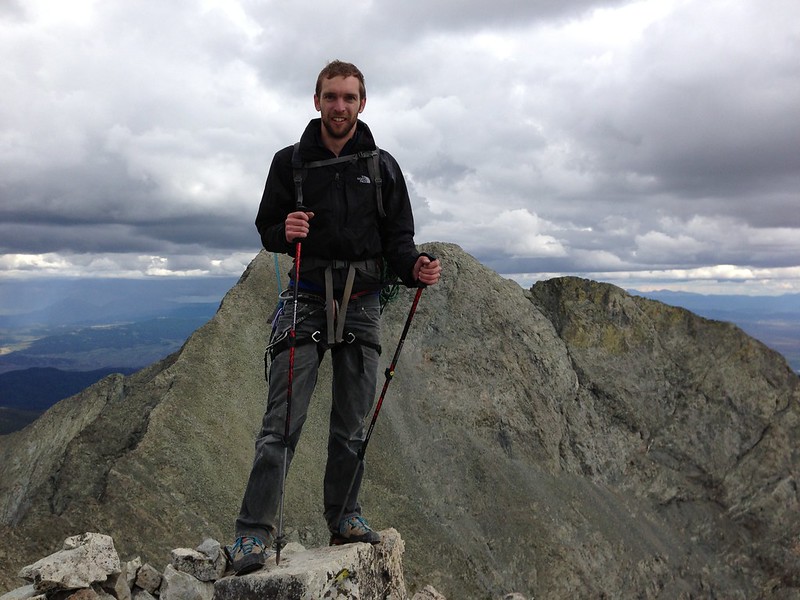
The author on the summit of Ellingwood Point
From the top, the best descent is on the easy fifth class (5.2, from what I hear) ridge. It's not, mind you, for the faint of heart.
As we were descending the ridge, we saw the rain clouds building up on the far side of the ridge. Just as we started descending, the drops came. We were able to avoid most of it, but it made for awesome scenery.
In all honesty, I think we're the first group to ascend the face of Ellingwood point. I'd rate it 5.9, with some very sustained 5.8 sections in between the crux moves. I'd have to rate the protection R for the choss alone, but if you really look you can find placements. If you know anyone who's been up there or wind up going yourself, please get in touch!
We left the car at 5:30am, and I didn't get back into camp until 9:30pm - after hiking the seven miles back to camp from the end of the climb. I skipped dinner. I was too exhausted to even think about boiling water, so I had a handful of trail mix and promptly passed out.
My alarm went off at 5:00 the next morning, and I rubbed the sleep from my eyes to hike up Mt. Lindsey, 14,048 feet for the ham14er event. But that's another story ;)

